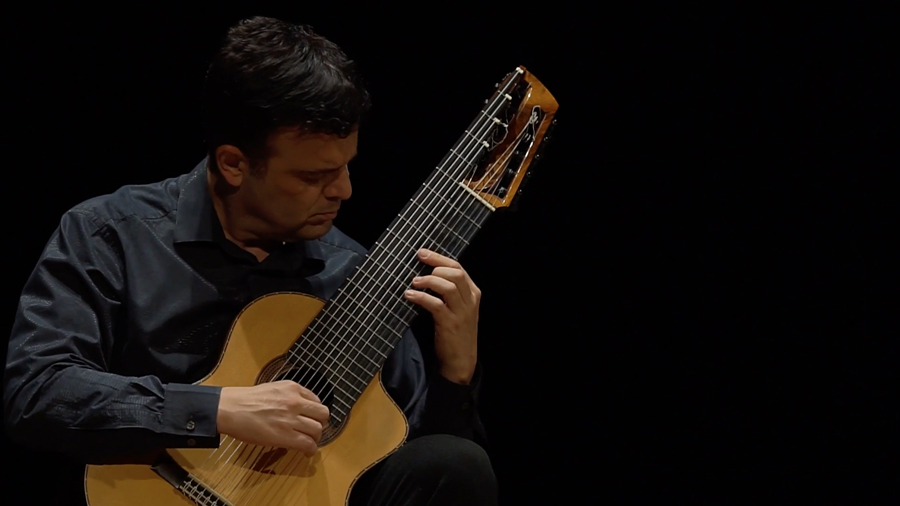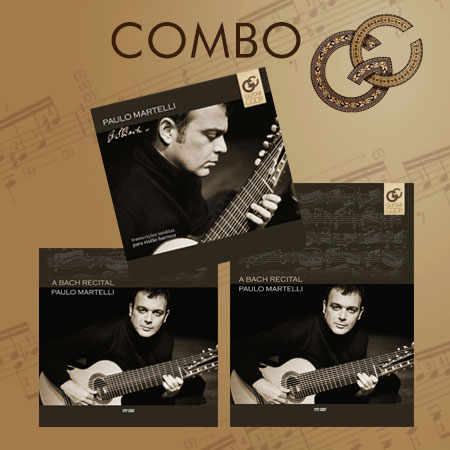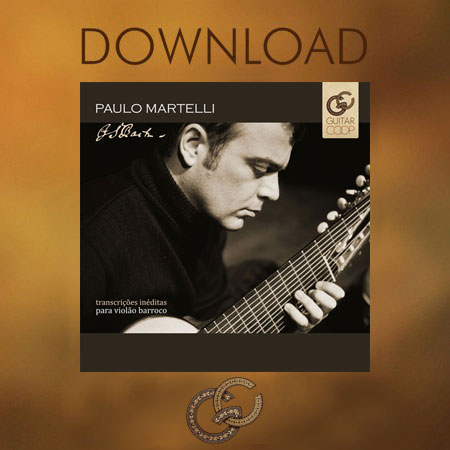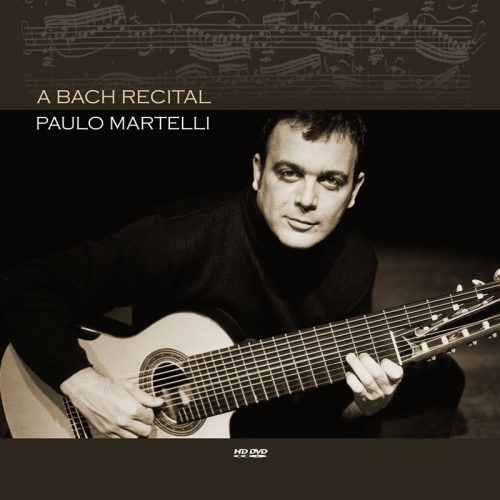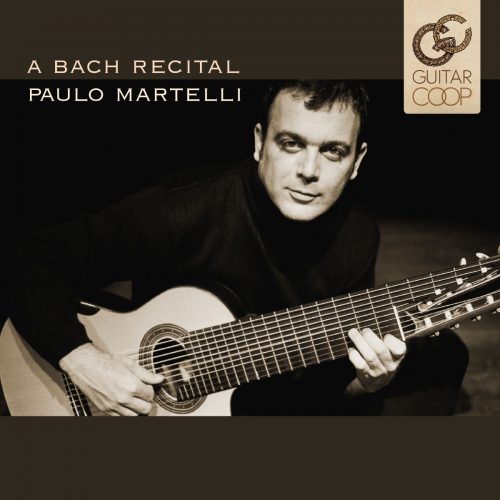A BACH RECITAL
The 11 string (alto) guitar came into my life in 2004 as a gift from the São Paulo luthier Samuel Carvalho. Although my fascination with the alto guitar was instant, it was only in 2007 that I decided to fully dedicate myself to this instrument. Immediately, I marveled at its sonorous beauty, expanded registers, and its rich texture. Gradually I became aware of the infinite possibilities of how I could adapt compositions of other instruments to the 11 string guitar. My first experiences with the 11 string guitar were realized on my 2006 album Miosótis. The music of Miosótis was heavily influenced by jazz and I found the 11 string guitar well suited to the challenges of representing low, middle, and high registers. Soon after I also adopted it for the Renaissance and Baroque repertoire, finding that with the 11 string guitar and the ranges it affords I could fully express my conception of the works of J. S. Bach (1685-1750).
This CD is the result of over 10 years of research in the adaptation, transcription and arrangement of J. S. Bach’s solo works for alto guitar. Since the 1960s, there has been vigorous growth of Historically Oriented Performance which has gradually become the standard practice for the interpretation of the Baroque repertoire. My interpretations of Bach, however, are not confined exclusively to this methodology. I am fond of several interpreters of the German master who have undoubtedly produced excellent readings of his works, even before the revolution of historical musicology. In my versions, I seek to fuse the knowledge of current trends to the passion of the romantic interpreters – a difficult but ideal combination for me. After all, Bach is a composer who found the perfect balance between emotion and reason.
Most of Bach’s instrumental music was composed in Cöthen (1717-1723). Among them are the 6 Cello Suites, the 3 Sonatas and 3 Partitasfor solo violin, the Violin Concertos, the Inventions for two and three voices, and many more keyboard pieces.
The present CD is centered on this rich period of Bach’s compositional output. The Suite BWV 1008 was composed in D minor, a tonality that, in the Baroque period, was related to feelings of regret, sadness and discouragement. The affections described by Baroque theorists for this tonality are confirmed by the wide use of rhetorical figures, in particular catabasis, found throughout the work. BWV 1008 is composed of six movements, but, curiously, Bach used the major tonality briefly in the second Minuet, giving this movement a very special sound contrast. The tonality used for the realization of this arrangement, in G minor, is understood by the Baroque theorists as capable of arousing feelings very similar to those of the original key, based on the theory of affections. In the suites for cello, Bach once again demonstrated his creative genius: by employing a small number of notes, he composed deep, perfect and complete music without the need for any additions. For this reason, the greatest difficulty in adapting the BWV 1008 Suite to the alto guitar is in recreating the counterpoint and complete harmony implied in its speech, without destroying the purity and balance of the original composition.
In solo works for violin, Bach pays homage to the Sonata da Chiesa and Sonata da Camara genres and, naturally, to the Italian composer Arcangelo Corelli (1653-1713), one of the greatest composers of these genres. The Chiesa Sonata, a priori, was intended to be performed in religious ceremonies. It consisted of four movements slow–fast (fugal)–slow–fast with respect to tempo. The opening of the first Sonata BWV 1001 is an Adagio whose function is to serve as a prelude to one of Bach’s most famous fugues. The third movement is a Sicilian with a melancholic and pastoral mood. The work ends with a Presto in moto perpetuo, in which the composer explores the virtuosic potential of the violin. This Sonata is considered one of the most perfect and balanced works of J. S. Bach, where the Italian style predominates. The arrangement for alto guitar keeps the original tonality, complementing the harmonies and counterpoints of the original for violin. When I made the arrangement of the second movement (Fuga). I used as base text Bach’s version for organ BWV 539, which allowed me to expand and diversify the possibilities of transcription in several passages of the work.
Adagio BWV 974 was adapted for alto guitar based on an arrangement by J. S. Bach’s of the Concerto for Oboe and Orchestra in D minor by Alessandro Marcelo (1673-1747). It is important to note that Bach left us – in addition to his incomparable compositional corpus – various arrangements of works by the masters of the Italian baroque, especially for organ and harpsichord. These arrangements are excellent examples of how great and accomplished an arranger Bach was. Not infrequently, he showed an almost miraculous dexterity, reducing to a single instrument both the orchestral richness and the singularity of the solo instrument. In this movement, Bach transfers the orchestral accompaniment to the left hand, which performs the chords in arpeggios, while the right hand solos the melody of the oboe, generously ornamented by the composer. In the adaptation for the alto guitar, I chose to keep the original mostly intact, changing the key a minor third above: F minor.
The Adagio BWV 1056 is an adaptation of the second movement of the Concerto in F minor by Cravo, written around 1738. Well-known musicologists claim that the Concertos by Cravo are based on violin works composed during the period in which Bach lived in Cöthen. The arrangement for alto guitar follows the example of Bach in the Adagio BWV 974, juxtaposing the orchestral mass and the solo part in a single instrument. This arrangement specifically consists of reducing the orchestral accompaniment, played in pizzicatos by the strings of the orchestra, in chords performed on the guitar in staccato, while the melody follows in legato. The original key of E flat major is replaced here by C major.
The Sinfonia BWV 795 is among Bach’s most profound and important works. Sinfonia is the title given by the composer to the three voice inventions. In this work, Bach employs the opposite/inverse counterpoint, creating a true musical kaleidoscope. The F minor key is replaced replaced by C minor in this arrangement for alto guitar.
This is my first CD recorded for GuitarCoop and to celebrate the occasion I chose as a bonus track the Minuet HWV 434, by G. F. Handel (1685-1757). Handel and Bach were born the same year, about 130 kilometers away though curiously they never met in person. It is known that in 1719, Bach traveled 35 kilometers to find Handel, though he had already left the city. In 1730, Wilhelm Friedemann Bach, the eldest of Johann Sebastian’s children, traveled to Halle, and invited Handel to visit his Leipzig family. This visit, for reasons unknown to date, never happened. In any case, both were the most notable composers of the Baroque period and are among my favorite composers. The Minuet was originally written for harpsichord, however, the version presented here was made from the arrangement of W. Kempff (1895-1991) for piano. This work presents the characteristic lamentation of the Baroque period and is one of the pearls of Baroque music literature. This piece, in particular, owes its great popularity to the piano version by Kempff.
I would like to end with a special thanks to the whole GuitarCoop team. This project has become possible thanks to the work and dedication of all. I extend my thanks to luthier Samuel Carvalho. By giving me two 11-string guitars, Samuel allowed me to explore J. S. Bach’s musical universe, changing the course of my career as a guitarist and lover of the Baroque repertoire. The instruments constructed by Samuel Carvalho have become more than tools of work: they have allowed me to find an artistic expression of their own and paved a path that I have traveled now for over a decade. This has led me, to my great contentment, to the music of Bach.
Paulo Martelli
São Paulo, January 31, 2017
Johann Sebastian Bach (1685-1750)
Sonata BWV 1001
1 – Adagio (3:46)
2 – Fuga (5:14)
3 – Siciliana (3:29)
4 – Presto (4:44)
5 – Sinfonia BWV 795 (4:27)
6 – Adagio BWV 974 (4:26)
Suite BWV 1008
7 – Prelude (4:08)
8 – Allemande (3:21)
9 – Courante (2:08)
10 – Sarabande (4:30)
11 – Minuet I & II (2:51)
12 – Gigue (2:33)
13 – Adagio BWV 1056 (3:22)
Bonus track:
G. F. Handel (1685-1759)
14 – Minuet HWV 434 (4:54)
* All works arranged for 11 string guitar by Paulo Martelli
Credits
Idealization: GuitarCoop
Recorded at: Auditório Unibes Cultural / Estudio Giba Favery
Dates: de 13 a 15, de 21 a 23, Outubro/October 2016
Sound Engineering: Ricardo Marui
Mixing: Ricardo Marui
Musical Producer: Henrique Caldas
Texts: Paulo Martelli
Graphic Design: Edson Vargas
Publishing / Web designer: Eduardo Sardinha
Photos: Ana Braga
Guitar: Samuel Carvalho (2004)
Strings: Augustine
Microphones: Royer SF-24, DPA 2006
Preamplifier: Millenia HV-3D
Monitoring: B&W 804
Speakers Amplifier: Anthem MCA 20
Cables: Audioquest King Cobra


 Português
Português
